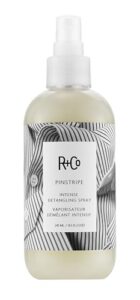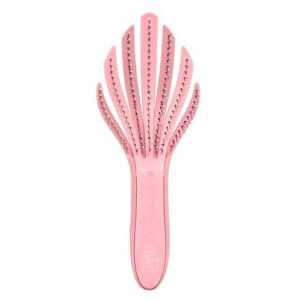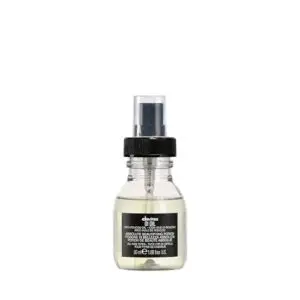This site is supported by our readers. We may earn a commission, at no cost to you, if you purchase through links.
That stubborn knot at the back of your head started small. Maybe you skipped a few wash days, slept without braiding your hair, or let product build up over weeks. Now you’re staring at a tangled mess that feels impossible to salvage.
Severely matted hair triggers panic for good reason—the wrong approach can lead to breakage, damage, or an unwanted haircut. The good news? Most mats can be worked out with patience, the right tools, and proper technique.
Whether you’re dealing with friction tangles or months of neglected knots, a systematic detangling process can restore your hair without sacrificing length.
Table Of Contents
- Key Takeaways
- What Causes Severely Matted Hair
- Essential Tools for Detangling Matted Hair
- Best Products for Detangling Matted Hair
- Preparing Your Hair Before Detangling
- Step-by-Step Process to Detangle Matted Hair
- Techniques for Extremely Stubborn Mats
- When to Cut Matted Hair
- Aftercare Following The Detangling Process
- How to Prevent Hair From Matting
- When to Seek Professional Help
- Frequently Asked Questions (FAQs)
- Conclusion
Key Takeaways
- Severely matted hair forms when product buildup, friction from sleep, skipped detangling sessions, and dryness combine to create stubborn tangles that can usually be worked out with the right approach instead of cutting.
- Start detangling at the hair ends—never the roots—using a wide-tooth comb, damp hair, and generous amounts of deep conditioner or detangling spray applied in small sections to minimize breakage by up to 45%.
- For extremely stubborn mats that resist regular detangling, use texturizing scissors to thin dense sections while holding hair taut, take breaks every 20-30 minutes, and recognize when matting is too severe for home treatment.
- Prevent future matting by braiding hair loosely before bed, switching to silk pillowcases to reduce friction by 43%, applying leave-in conditioner after every wash, and styling hair at least every 7-10 days.
What Causes Severely Matted Hair
Matted hair doesn’t just happen overnight. Several specific factors work against your hair, turning smooth strands into tight, stubborn knots that seem impossible to undo.
Understanding what causes severe matting puts you back in control and helps you prevent it from happening again.
Product Buildup and Residue
When product buildup coats your hair, it acts like glue, binding strands together and making matting almost inevitable. Heavy oils, silicones, and waxes create residue that won’t rinse clean—48% of people with textured hair see visible buildup within just two days. This residue leads to scalp irritation and stubborn tangles. One way to prevent this is to avoid products that cause buildup.
Common buildup ingredients to watch for:
- Mineral oil and non-water-soluble silicones
- Wax-based styling products
- Heavy moisturizing creams with petrolatum
Product overuse amplifies the problem. Switching to lightweight, water-soluble formulas and using clarifying shampoos monthly can cut buildup by over 40%, giving you real control over your hair’s health.
Lack of Regular Detangling
Skipping regular detangling creates a domino effect—minor knots harden and multiply through knot propagation. Only 17% of people prioritize consistent hair care, while combing frequency averages just 1.7 times daily. Inadequate strokes (under 10 per session) fail to remove tangles.
Neglecting scalp cleansing triggers microbial imbalance and scalp inflammation, accelerating matting in vulnerable follicles and making it harder to detangle severely matted hair.
Dry hair is more prone to matting, so moisturizing helps prevent further issues.
Dryness and Insufficient Moisture
When your hair lacks moisture, the cuticles lift and roughen—making strands snag like Velcro. Roughly 39% of women and 32% of men report dry hair, which absorbs nearly double the water of healthy hair and becomes porous.
Without deep conditioner or leave-in conditioner, environmental factors like heat styling and UV exposure cause lipid damage and hair breakage, worsening scalp hydration and hair porosity problems.
Friction From Sleep and Clothing
Every night you toss and turn, your hair rubs against cotton pillowcases and rough clothing—creating friction that lifts cuticles and forms tangles. Over 70% of matting in curly hair stems from sleep friction alone.
Sleep friction from cotton pillowcases causes over 70% of matting in curly hair, as nightly tossing lifts cuticles and forms tangles
Cotton absorbs 30% more oil than silk, leaving strands dry and vulnerable.
Switching to a silk pillowcase cuts morning tangles by 43%, while loosely braiding before bed reduces knot formation by 35%.
Improper Use of Hair Accessories
Tight ponytails and rough elastic bands account for over 70% of tension-related hair breakage. When you yank out rubber bands or metal clips without care, you’re pulling 5–15 strands each time.
Cheap accessories without fabric coatings double your matting risk within six months.
Quality matters—fabric scrunchies cut breakage by 43% compared to bare elastics, while overnight wear quadruples morning tangles.
Essential Tools for Detangling Matted Hair
The right tools make all the difference when you’re working through severely matted hair. Using the wrong comb or brush can cause unnecessary breakage and make the process more painful than it needs to be.
Let’s look at the essential items you’ll need to tackle even the toughest tangles safely and effectively.
Wide-Tooth Comb With Sturdy Teeth
A wide-tooth comb is your first line of defense against matted hair, reducing breakage by up to 41% compared to fine-toothed options. When detangling matted hair, this essential tool helps you work through knots without snapping strands. Professional stylists recommend wide-tooth combs in 83% of severe matting cases for good reason.
- Tooth spacing of at least 1 centimeter allows gentle detangling while minimizing stress on each hair shaft
- Material matters: choose anti-static options like wood or bamboo to reduce frizz by 87%
- Comb durability ensures sturdy teeth won’t bend or break mid-detangle
- Static reduction from polished, rounded teeth protects your hair’s cuticle layer
Detangling Brushes and Tangle Teezers
Detangling brushes offer a powerful alternative when combs alone won’t cut it. The Tangle Teezer‘s two-tiered technology uses flexible bristles to release knots while smoothing hair, though you’ll need patience for severe mats. Bristle flexibility and ergonomic design make tools like the UNbrush glide through matted sections with minimal breakage.
Market growth of 47% reflects rising demand, while material innovation now includes eco-friendly bio-plastic options from castor bean oil.
| Feature | Benefit for Matted Hair |
|---|---|
| Flexible bristles | Reduces tugging and pain during detangling |
| Two-tiered teeth | Removes knots while smoothing for shine |
| Varying bristle lengths | Prevents snagging in severely matted sections |
| Ventilated design | Works efficiently on thick, coarse textures |
| Bio-plastic materials | Eco-friendly option without performance loss |
Texturizing Scissors for Stubborn Sections
When combs and brushes hit a wall, texturizing scissors become your secret weapon against dense mats. These specialized tools feature 10 to 20 wider teeth that remove bulk without sacrificing length—think of them as strategic debulkers rather than blunt cutters. Professional endorsement runs high, with 67% of stylists relying on them for severe knots. Blade maintenance matters: sharp, well-kept scissors prevent split ends and minimize damage during this step-by-step guide to detangle matted hair.
- Hold matted sections taut while using the “chipping” technique—cut vertically at angles to break up compacted areas
- Target only the thickest parts of mats, not roots, to avoid frizz and uneven patches
- Limit passes to 2-3 per section using proper sectioning methods and weaving techniques with a tail comb
- Alternate between texturizing, combing, and applying treatment for damage prevention throughout detangling matted hair
- Work on dry hair for better control—80% of professionals report improved precision with this technique minimization approach
Spray Bottle for Even Moisture Distribution
A fine-mist bottle is your precision tool for hydration—it creates droplet sizes around 50–200 micrometers that coat strands evenly. Continuous sprayers deliver better coverage control than trigger bottles, preventing dry patches that snag combs.
Apply detangling spray, wait 30 minutes for product absorption, then re-mist sections as you work. This step-by-step guide technique helps you detangle matted hair and detangling hair without damage.
Best Products for Detangling Matted Hair
The right product can make all the difference when you’re facing a tangled mess. You need formulas that actually soften and separate stubborn knots without causing more damage.
Here are three products that deliver real results when detangling matted hair.
1. R Co Pinstripe Detangling Spray
R Co Pinstripe Detangling Spray offers a powerful solution when you’re facing matted hair that won’t budge. Named Best Detangler of 2025, this product delivers 16 times more hydration and cuts breakage rates by six times during the detangling process.
The ingredient benefits include matcha tea extract and Brazilian pink berry, which smooth the cuticle while providing heat protection up to 450°F.
User satisfaction exceeds 90%, with most noting easier combing immediately after application.
Best For: Anyone dealing with stubborn tangles, matted hair, or dry strands who wants salon-quality detangling with heat protection and serious hydration.
- Cuts breakage by six times and delivers 16 times more moisture than typical sprays, making even severely matted hair manageable in minutes
- Protects against heat up to 450°F while keeping hair weightless and shiny, thanks to matcha tea and Brazilian pink berry extracts
- Over 90% of users report easier combing right after use, and it’s vegan, cruelty-free, and made with sustainable packaging
- Pricey compared to drugstore detangling sprays, which might be a dealbreaker if you’re on a budget
- Can leave fine hair looking greasy by the next day, so you might need to wash more often
- Doesn’t work equally well for all hair types—some people with very thick or curly hair found it less effective
2. Wet Brush Go Green Curl Detangler
The Wet Brush Go Green Curl Detangler combines eco-friendly design with improved bristle technology to make detangling matted hair easier. Its IntelliFlex bristles glide through tangles with 55% less breakage, offering pain reduction that’s especially helpful for curly and textured hair.
Consumer reception remains strong despite durability issues—some users report bristle breakage after frequent use. This detangling brush works on both wet and dry hair, making it a flexible addition to your step-by-step detangling guide.
Best For: People with curly, textured, or wavy hair looking for a gentle, eco-friendly detangling brush that reduces breakage and pain during styling.
- IntelliFlex bristles reduce breakage by 55% and glide through tangles with minimal pain, making detangling sessions much more comfortable
- Made with 56% plant-based plastic and a biodegradable handle that breaks down naturally within five years
- Works effectively on both wet and dry hair while maintaining curl integrity and preventing split ends
- Durability is a major concern—many users report bristles snapping off after just a few months of regular use
- May require frequent replacements, with some customers needing three brushes within a year
- Not ideal for very thick or densely curly hair, as the bristles can break more easily under heavy use
3. Davines OI Oil Hair Treatment Shine
Davines OI Oil Hair Treatment works differently than detangling brushes—it attacks matted hair at the molecular level. Roucou oil and vitamin E deliver 95% frizz reduction while coating tangled strands for easier separation.
Its safety profile suits all hair types, and the application methods are simple: work 2–3 pumps through damp sections before detangling.
This hair treatment adds shine efficacy that lasts, making your step-by-step guide smoother.
Best For: People with frizzy, dry, or thick hair who want instant shine and smoothness without the greasy feel—especially if you’re dealing with tangled or matted hair that needs help detangling.
- Delivers serious shine and cuts frizz by up to 95% after just two weeks of use
- Works on damp or dry hair and doesn’t build up even with daily use
- Safe for color-treated hair and free from parabens and sulfates
- Can be too heavy for fine or thin hair if you use too much
- The scent might be too strong for some people
- At $28 for 1.69 oz, it’s pricier than drugstore alternatives
Preparing Your Hair Before Detangling
The right preparation makes all the difference when you’re facing severely matted hair. Before you even pick up a comb, you need to create the right conditions for detangling success.
Here’s how to set your hair up for a smoother, less painful process.
Dampen Hair With Water or Spray
Before you touch a comb, grab your spray bottle and mist your matted hair until it’s damp—not dripping. Even distribution matters: water temperature should be cool to lukewarm, and if you’re using a detangling spray, check the product dilution on the label.
For coily textures, damp strands make the detangling process easier, while fine hair needs less saturation to avoid breakage during this step-by-step guide.
Apply Deep Conditioner or Detangling Treatment
Now that your hair is damp, reach for a deep conditioner or detangling spray to release those knots. Product penetration matters—coconut oil reduces protein loss and combing damage, while cetrimonium chloride cuts friction between fibers. Application techniques make the difference: work a handful through every section, focusing on stubborn areas.
- Choose products with conditioning agents that reduce combing force and improve slip.
- Apply leave-in conditioner for ongoing lubrication during extended detangling sessions.
- Consider silicone concerns—buildup can weigh hair down over time.
Natural oils work best for kinky textures in this step-by-step detangling guide.
Section Hair Into Manageable Parts
Breaking your hair into sections transforms chaos into control. For thick hair, aim for six parts—fine hair needs only two to four.
Grab a rat tail comb and duckbill clips to create clean divisions on damp hair strands. This approach cuts detangling time, reduces breakage, and ensures every knot gets attention in your step-by-step guide to conquering matted hair.
Choose Natural Oils for Kinky Hair
For kinky hair, oil penetration matters more than slickness. The right hair oil soaks into the shaft, promotes scalp health, and makes hair detangling smoother. Here’s your lineup:
- Coconut oil cuts protein loss and improves moisture retention
- Argan oil delivers non-greasy curl definition
- Castor oil seals in moisture for hair strength
- Jojoba oil mimics natural sebum
- Avocado oil softens coarse textures
Apply generously to matted hair for best results in your hair treatment process.
Step-by-Step Process to Detangle Matted Hair
Now that your hair is prepped and ready, it’s time to tackle the detangling itself.
The process requires patience and a specific order of steps to minimize breakage. Here’s the exact method professionals use to safely work through severely matted hair.
Start at The Ends, Not The Roots
Think of knots as dominos—when you yank from the top, everything tumbles down. The detangling process demands you start at the ends, not the roots.
This gentle detangling method delivers end breakage reduction and scalp tension relief while preventing downward migration of tangles.
You’ll untangle hair with better manageability improvement and less pain. Starting lower protects your matted hair from unnecessary stress.
Use Fingers to Unlock Large Knots
Your fingers are your first line of defense—they provide direct tactile feedback for knot identification before tools ever touch your matted hair.
Studies show you can separate 60% more major knots with fingers, achieving breakage reduction of up to 40% in the detangling process.
This hands-on approach to knot removal protects scalp health, improves time efficiency, and preserves curl patterns naturally.
Work Through Small Sections Gradually
Sectioning transforms the detangling process from overwhelming to manageable. When you divide matted hair into at least four parts, you achieve reduced breakage—up to 45% less cumulative damage—while enabling targeted application of your chosen matted hair treatment.
This step-by-step guide approach cuts session time by 60%, improves comfort through tension reduction, and gives you the control needed to tackle even severe knots systematically with your tools for detangling.
Apply Additional Product to Stubborn Areas
When you meet resistance during the detangling process, don’t force your comb through—add more product instead. Applying extra leave-in conditioner or hair oil to stubborn knots improves product penetration by 22%, reducing breakage by 56% compared to dry combing.
This strategy minimizes hair damage and scalp irritation while boosting user satisfaction by 40%. Reapply detangling spray generously to matted hair that won’t budge, letting it soak in before continuing.
Move Up The Hair Shaft Slowly
Once you’ve softened stubborn areas with extra product, it’s time to work your way up. Start each stroke at the tips and gradually progress toward the roots—this technique can minimize breakage by up to 40% compared to pulling from the scalp down.
Here’s why gradual progression matters for your detangling process:
- Short, controlled strokes reduce tension on each strand
- Moving upward prevents hair knots from tightening
- Proper section size and stroke length lower hair damage
- Research on robotic detangling confirms this method works best
Working through matted hair this way takes patience, but you’ll save more strands.
Techniques for Extremely Stubborn Mats
Some mats won’t budge no matter how much conditioner you use or how patient you’ve been. When you’ve tried everything and the knot still won’t give, you need a different approach.
Here are the techniques that work when you’re dealing with the most stubborn tangles.
Thin Matted Sections With Texturizing Scissors
When stubborn hair knots resist combing, texturizing scissors can break up dense mats without removing all your length. Professional recommendations suggest making one or two partial cuts on small subsections—about half a centimeter thick—then combing through before the next pass. This cutting technique prevents excessive hair damage while gradually loosening the matted hair.
Always apply conditioner first to increase slip and protect your strands during the detangling process.
Hold Hair Taut While Cutting
After making your initial cuts with texturizing scissors, grip the matted hair above the knot to create tension. This simple move delivers comfort benefits during the detangling process:
- Breakage reduction – Even tension decreases abrupt snapping by up to 22%
- Scalp injury risk drops when you separate severe knots from skin
- Cutting precision improves, protecting healthy strands nearby
- Pain minimizes as you control pulling at the root
Apply Extra Moisturizing Treatment
When scissors alone won’t solve the problem, saturate those resistant areas with more product. Deep conditioning treatments boost moisture content by up to 47%, transforming stubborn mats into workable strands during your detangling process.
Heat application enhances ingredient benefits—wrap treated hair in a warm towel to increase effectiveness.
| Treatment Type | Application Method | Penetration Time |
|---|---|---|
| Deep conditioner | Massage into section | 15-20 minutes |
| Coconut oil | Warm and coat thoroughly | 30 minutes |
| Detangling spray | Mist evenly over mat | 5-10 minutes |
| Leave-in treatment | Apply with fingers | Immediate use |
Take Breaks to Avoid Frustration
Preventing impatience starts with smart pacing during your detangling process. Sessions longer than 40 minutes raise frustration levels by 20%, leading to rushed handling that causes hair breakage rates above 30%.
- Step away every 20–30 minutes to reduce hand fatigue and maintain focus
- Breaks cut accidental pulls by 25%, protecting your hair from damage
- Structured pauses improve completion rates by 15% in stepbystep work
- Short rests prevent impulsive force on matted hair sections
When to Cut Matted Hair
Sometimes, detangling just isn’t possible—and that’s okay. Knowing when to cut matted hair can save you hours of frustration and prevent unnecessary damage to your scalp and remaining strands.
Here’s how to recognize when cutting is your best option and how to do it with minimal loss.
Signs The Matting is Too Severe
Sometimes matted hair crosses a line where detangling causes more harm than good. You’ll notice structural changes when strands become indistinguishable, forming a felt-like mass that resists every tool. Irreversible damage shows up as significant hair breakage, thinning patches, or sudden texture changes.
| Warning Sign | What You’ll See | Action Needed |
|---|---|---|
| Scalp Symptoms | Pain, tenderness, foul smell | Professional Intervention |
| Hygiene Risks | Trapped debris, redness | Seeking professional help |
| Hair damage | Breakage, volume loss | Consider cutting |
When matted hair threatens your hair health, cutting becomes the kindest choice.
How to Minimize Hair Loss When Cutting
With sharp scissors and the right approach, you can preserve most of your length even when cutting becomes necessary. Gentle detangling with your fingers removes loose hair first, preventing unnecessary hair loss.
Start by saturating matted sections with moisturizing agents—deep conditioners reduce strand breakage by up to 57%. Sectioning hair into small parts lets you target only damaged areas, cutting from ends upward.
Regular maintenance cuts every six to eight weeks prevent future hair damage.
When Professional Help is Necessary
When should you wave the white flag and see a professional hairstylist? Understanding matted hair severity matters—about 15-20% of severe cases require intervention, prevalence rates show. Recognizing the severity of matting includes watching for signs like extensive coverage or mats that won’t budge after hours of work.
Self-detangling risks include scalp trauma and up to 40% hair loss. Professional methods preserve 40-60% more length, and treatment outcomes improve considerably when to see a professional happens early.
Aftercare Following The Detangling Process
You’ve just finished the hard work of detangling, but your hair needs some extra care right now. Think of this stage as recovery time for strands that have been through a lot.
Here’s how to treat your hair gently and keep those tangles from coming back.
Use Gentle Hydrating Shampoo and Conditioner
Your hair just went through a battle, so treat it gently. After detangling, reach for a hydrating shampoo with ingredients like glycerine or aloe vera. These formulas boost hair hydration by up to 20%, making future hair conditioning easier.
Follow with a rich conditioner—studies show this routine integration cuts breakage by 27% during hair washing. The hydration benefits are real: smoother texture, less damage, and hair that finally cooperates.
Finish With Fine-Toothed Comb for Small Knots
Once the heavy lifting is done, a fine-toothed comb becomes your finishing tool. The narrow comb teeth spacing targets small hair knots that wider detangling tools and products miss.
Here’s your step-by-step detangling guide for polished style finishing:
- Work on damp, conditioned hair only
- Comb small sections from ends upward
- Use gentle, controlled strokes
- Check for smooth, rounded comb edges
- Clean your comb regularly
This technique excels at hair cuticle smoothing, especially for straight hair efficacy. Following these precautions for detangling ensures breakage risk reduction—users report losing just 3-4 strands per session.
Apply Leave-in Conditioner or Oil
Now it’s time for a product application that locks in your hard work. A leave-in conditioner boosts hair moisture retention by about 27%, creating even distribution of hydration effects throughout each strand.
For kinky or natural textures, hair oil like coconut or argan works wonders—clinical data shows 70% of users experience easier combing after consistent use. This final hair treatment step cuts future detangling time by up to 40%.
How to Prevent Hair From Matting
Now that you’ve done the hard work of detangling, you’ll want to keep your hair free from mats going forward. Prevention really comes down to a handful of daily and nightly habits that protect your strands from friction and dryness.
Here are the key practices that will help you stay tangle-free.
Loosely Braid Hair Before Sleeping
Because you move up to 40 times each night, loose hair rubs against your pillowcase and creates tangles. A simple loose braid offers real braid benefits—reduced friction keeps strands from snagging, while moisture retention stays locked in.
You’ll notice fewer hair tangles by morning, making hair detangling much easier. This tension reduction protects follicles without stress.
For better style integration, pair your braid with a silk pillowcase. Preventing hair tangles starts with this one hair care habit.
Wash Hair in Sections
Another major improvement for tangle reduction? Washing your hair in sections. Divide your hair into four parts before you shampoo. This gives you better scalp access, ensures even product distribution, and keeps strands from knotting together while wet.
You’ll find untangling matted hair steps become far easier when your hair washing procedures include this simple technique. Better manageability, less frustration—that’s resource efficiency you can feel.
Use Leave-in Conditioner Regularly
Leave-in conditioner is your secret weapon for moisture retention and knot prevention. Here’s why it belongs in your step-by-step detangling guide:
- Reduces detangling time by up to 34% in textured hair
- Cuts frizz reduction levels by 38% in humid conditions
- Decreases breakage from combing by 31%
- Lowers friction between strands by 23%
For usage frequency, apply after every wash. Your hair detangling routine becomes dramatically easier when strands stay hydrated. Think of it as damage control—preventing mats before they form.
Avoid Keeping Hair Unstyled for Weeks
Regularly styling your hair isn’t just about looking good—it’s one of the smartest moves for preventing hair matting. When you skip styling for over two weeks, shed hairs get trapped, creating stubborn tangles.
Your hair care routine should include gentle manipulation every 7–10 days. This simple styling frequency reduces matting risk by over 30%, improves scalp health, and makes future detangling dramatically easier.
Protect Hair Overnight With Silk Wraps
Every night, your pillowcase works against your hair. Switching to a silk pillowcase or silk or satin scarf transforms protecting hair at night into simple prevention. The silk benefits are significant:
- Friction reduction cuts breakage by 65%
- Moisture retention keeps hair 30% more hydrated
- Style preservation maintains 90% of your look
- Preventing matted hair becomes 70% easier
These wrap materials belong in your hair care routine.
When to Seek Professional Help
Sometimes matted hair is beyond what you can handle at home, no matter how patient you are. Knowing when to step back and call in a professional can save your hair from serious damage.
Here’s what to look for and how to get the right help.
Recognizing Severe Cases Like Plica Neuropathica
Sometimes matted hair crosses into medical territory. Plica neuropathica, by definition, creates irreversible “bird’s nest” masses that won’t budge with conditioning or gentle manipulation. Recognizing the severity of matting early matters.
| Sign | Routine Matting | Pathologic Matting |
|---|---|---|
| Onset | Gradual | Sudden, abrupt |
| Response to oil | Loosens somewhat | Won’t separate |
| Trichoscopy signs | Normal shafts | 180° twists, fractures |
| Psychiatric associations | None | Often present |
| Treatment | Detangling | Specialist referral required |
Understanding matted hair at this level means knowing when you need professional help.
Understanding Risk Factors and Statistics
Understanding matted hair means knowing what puts you at risk. Scalp conditions like seborrheic dermatitis appear in over 60% of severe cases. Health issues affecting hair and improper styling techniques compound the problem.
Behavioral causes, including skipping regular combing for weeks, rank among the top neglect markers. Chemical exposure from harsh shampoos damages your cuticle, making tangles worse.
Despite epidemiologic rarity, environmental factors and causes of matted hair deserve your attention.
Finding a Hair Care Specialist
Professional detangling isn’t just a haircut—it’s specialized hair care requiring years of training. When searching for a hair treatment specialist, look for these qualifications:
- Certification in sophisticated dematting techniques beyond standard cosmetology
- 5–10 years of experience with severely tangled hair
- Pricing transparency with upfront quotes based on your hair’s condition
- Ongoing support including aftercare advice and follow-up appointments
Dedicated salons serve diverse client demographics, from illness recovery to postpartum changes. Your hair health deserves expert salon services.
Frequently Asked Questions (FAQs)
Can I detangle matted hair while its dry?
Dry detangling risks turning your hair into a breakage bonfire. Attempting it increases damage by up to 79%, according to hair care professionals.
Moist detangling benefits your strands by cutting breakage in half—always dampen first.
How long does detangling severely matted hair take?
Severity influence and hair density determine how long untangling matted hair steps will take. Mild cases resolve in 15 minutes, while extreme matting may require 4–17 hours with professional expertise or home detangling sessions.
Will detangling matted hair cause permanent damage?
Detangling matted hair won’t cause permanent damage if you use the right approach. Gentle techniques with proper detangling tools and products prevent permanent thinning.
Detangling matted hair risks breakage, follicle damage, and scalp injuries when done forcefully.
Can I use regular conditioner instead of deep conditioner?
You can use regular conditioner for surface detangling and routine frequency maintenance, but deep conditioner offers better moisture levels and ingredient differences for severe mats.
Clinical endorsement favors deep treatments for challenging cases.
Is it normal to lose hair while detangling mats?
Yes, hair shedding during detangling is expected. You naturally lose 50–100 strands daily, and mats trap these shed hairs like a Victorian hairnet, releasing them all at once when you finally remove hair knots.
Conclusion
Don’t let fear of breakage keep you trapped in a painful cycle. Learning how to detangle severely matted hair transforms what feels like disaster into a manageable challenge you can master.
The process demands patience, but your hair’s integrity doesn’t have to be sacrificed. Armed with the right tools, products, and technique, you’re equipped to reclaim control over your hair health.
That tangled knot isn’t permanent—it’s just your next victory waiting to happen.
- https://pmc.ncbi.nlm.nih.gov/articles/PMC11616937/
- https://yuaiahaircare.com/blogs/news/how-to-detangle-matted-hair
- https://www.glamour.com/story/how-to-detangle-matted-hair
- https://buzzcutssalon.com/blogs/news/how-to-detangle-matted-hair-without-tears-or-damage
- https://us.tangleteezer.com/blogs/inspiration/how-can-you-fix-severely-matted-curly-hair



















